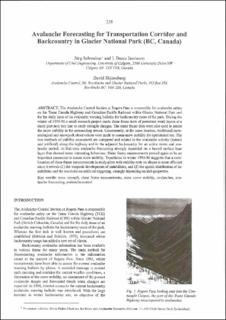Avalanche forecasting for transportation corridor and backcountry in Glacier National Park (BC, Canada)
Abstract
The Avalanche Control Section at Rogers Pass is responsible for avalanche safety on the Trans Canada Highway and Canadian Pacific Railroad within Glacier National Park and for the daily issue of an avalanche warning bulletin for backcountry users of the park. During the winter of 1995-96 a small research project made shear frame tests of persistent weak layers at a study plot near tree line to study strength changes. The shear frame data were also used to assess the snow stability in the surrounding terrain. Concurrently, at the same location, traditional meteorological and snowpack observations were made to assess snow stability for operational use. The two methods of stability assessment are compared and related to the avalanche activity (natural and artificial) along the highway and in the adjacent backcountry for an active storm and avalanche period. At that time avalanche forecasting strongly depended on a buried surface hoar layer that showed some interesting behaviour. Shear frame measurements proved again to be an important parameter to assess snow stability. Experience in winter 1995-96 suggests that a combination of shear frame measurements in study plots with stability tests on slopes is most efficient since it reveals (1) the temporal development of instabilities, and (2) the spatial distribution of instabilities and the reactivity on artificial triggering, strongly depending on slab properties.
